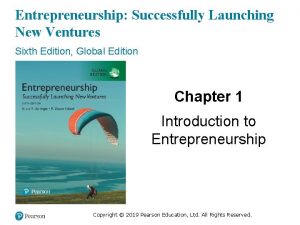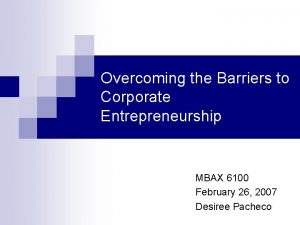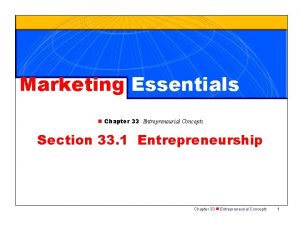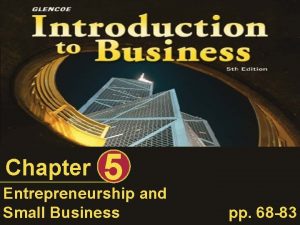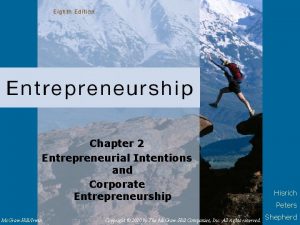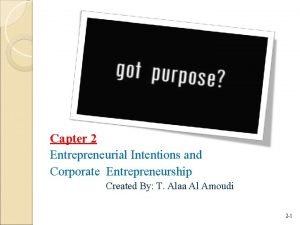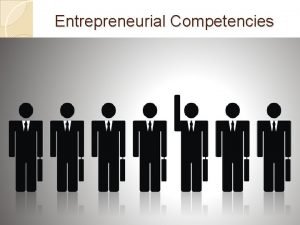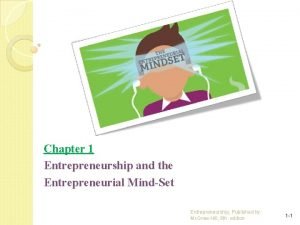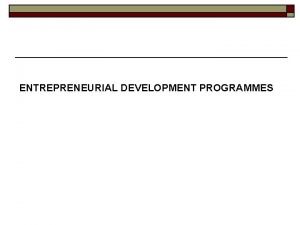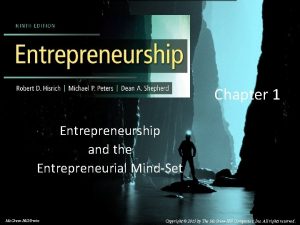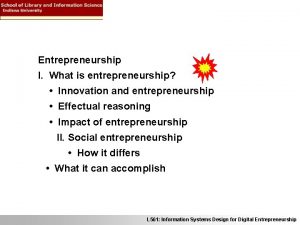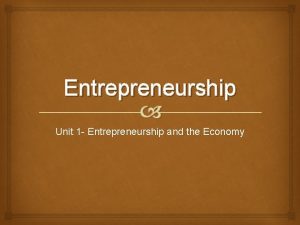Chapter 2 Entrepreneurial Intentions and Corporate Entrepreneurship 2014



















- Slides: 19

Chapter 2 Entrepreneurial Intentions and Corporate Entrepreneurship © 2014 by Mc. Graw-Hill Education. This is proprietary material solely for authorized instructor use. Not authorized for sale or distribution in any manner. This document may Mc. Graw-Hill/Irwin Copyright © 2013 by The Mc. Graw-Hill Companies, Inc. All rights reserved. not be copied, scanned, duplicated, forwarded, distributed, or posted on a website, in whole or part.

Learning Objectives • To understand the causes of interest in corporate entrepreneurship • To introduce the “entrepreneurial” mode of managing firms and distinguish it from the traditional mode • To provide a scale for capturing the extent to which management adopts entrepreneurial or traditional behaviors 2 -2

Learning Objectives • To discuss how established firms can develop an entrepreneurial culture and the challenges of doing so • To acknowledge that projects fail and people feel bad about it, and to introduce the dual process model for maximizing learning from failure experiences 2 -3

Causes for Interest in Corporate Entrepreneurship • Corporate entrepreneurship • Entrepreneurial action within an established organization • Capitalizes on individuals who can do things differently and better 2 -4

Causes for Interest in Corporate Entrepreneurship • Causes for interest • Desire for responsibility • Strong need for individual expression and freedom • Discontent within the structured organization 2 -5

Table 2. 1 - Distinguishing Entrepreneurially from Traditionally Managed Firm 2 -6

Managerial Versus Entrepreneurial Decision Making • Strategic orientation • Focuses on factors that are inputs in formulation of the firm’s strategy • Entrepreneurial orientation toward opportunity • Commitment to take action on potential opportunities 2 -7

Managerial Versus Entrepreneurial Decision Making • Entrepreneurial orientation toward commitment of resources • Minimizes resources that would be required in pursuing a particular opportunity • Entrepreneurial orientation toward control of resources • Focuses on how to access others’ resources 2 -8

Managerial Versus Entrepreneurial Decision Making • Entrepreneurial orientation toward management structure • More organic focus • Has few layers of bureaucracy between top management and the customer 2 -9

Managerial Versus Entrepreneurial Decision Making • Entrepreneurial philosophy toward rewards • Compensation is based on generation and exploitation of opportunity • Entrepreneurial orientation toward growth • Entrepreneurial orientation toward culture • Encourages employees to generate ideas, and engage in tasks that might produce opportunities 2 -10

Table 2. 3 - Characteristics of an Entrepreneurial Environment 2 -11

Table 2. 4 - Leadership Characteristics of a Corporate Entrepreneur 2 -12

Establishing Corporate Entrepreneurship in the Organization • Step one • Secure a commitment from top, upper, and middle management levels • Identify, select, and train corporate entrepreneurs • Step two • Identify ideas and areas that interest top management • Identify amount of risk money available 2 -13

Establishing Corporate Entrepreneurship in the Organization • Establish overall program expectations and target results • Establish time frame, volume, and profitability requirement • Establish mentor/sponsor system • Step three • Use of technology to ensure organizational flexibility 2 -14

Establishing Corporate Entrepreneurship in the Organization • Step four • Identify interested managers to train employees • Step five • Develop ways to get closer to the customers • Step six • Learn to be more productive with fewer resources • Step seven • Establish a strong support structure for corporate entrepreneurship 2 -15

Establishing Corporate Entrepreneurship in the Organization • Step eight • Tie rewards to the performance of the entrepreneurial unit • Finally • Evaluation system should be such that: • Successful entrepreneurial units thrive • Unsuccessful ones are eliminated 2 -16

Problems and Successful Efforts • Compared to new ventures started within a corporation, independent start-ups: • Perform better • End up twice as profitable • Reasons cited • Corporation’s difficulty in maintaining a long-term commitment • Lack of freedom to make autonomous decisions • Constrained environment 2 -17

Learning from Failures • Dual process model of coping with negative emotions • Oscillation between a loss orientation and a restoration orientation • Loss orientation • An approach to negative emotions that involves: • Working through and processing some aspect of the loss experience • Breaking emotional bonds to the object loss 2 -18

Learning from Failures • Restoration orientation • An approach to negative emotions based on: • Both avoidance and proactiveness toward secondary sources of stress arising from a major loss 2 -19
 Corporate entrepreneurial mindset
Corporate entrepreneurial mindset Introduction to entrepreneurship module pdf
Introduction to entrepreneurship module pdf Types of corporate entrepreneurship
Types of corporate entrepreneurship Types of corporate entrepreneurship
Types of corporate entrepreneurship Causes for interest in corporate entrepreneurship
Causes for interest in corporate entrepreneurship Barriers to corporate entrepreneurship
Barriers to corporate entrepreneurship Wharton field challenge
Wharton field challenge Models of corporate entrepreneurship
Models of corporate entrepreneurship Objective of corporate governance
Objective of corporate governance Learning intentions examples
Learning intentions examples Learning intentions and success criteria examples
Learning intentions and success criteria examples Learning intentions and success criteria for mathematics
Learning intentions and success criteria for mathematics Learning intentions and success criteria examples
Learning intentions and success criteria examples Going to is used for plans, decisions and intentions.
Going to is used for plans, decisions and intentions. Thoughts and intents of the heart
Thoughts and intents of the heart 7 pathways
7 pathways Chapter 33 entrepreneurial concepts
Chapter 33 entrepreneurial concepts Chapter 6 entrepreneurship and small business management
Chapter 6 entrepreneurship and small business management Chapter 5 entrepreneurship and small business
Chapter 5 entrepreneurship and small business Entrepreneurship chapter 5
Entrepreneurship chapter 5


